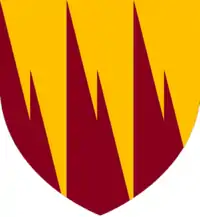Solly Zuckerman, Baron Zuckerman
Solomon "Solly" Zuckerman, Baron Zuckerman OM KCB FRS[1] (30 May 1904 – 1 April 1993) was a British public servant, zoologist and operational research pioneer. He is best remembered as a scientific advisor to the Allies on bombing strategy in the Second World War, for his work to advance the cause of nuclear non-proliferation, and for his role in bringing attention to global economic issues.[2][3][4][5]
The Lord Zuckerman | |
|---|---|
 Zuckerman photographed in Tobruk in 1943 during the Western Desert Campaign | |
| Born | Solomon Zuckerman 30 May 1904 |
| Died | 1 April 1993 (aged 88) |
| Citizenship | British |
| Alma mater | University of Cape Town Yale University |
| Awards |
|
| Scientific career | |
| Fields | Zoology, anatomy, operational research |
| Institutions | University of Oxford University of Birmingham University of East Anglia |
| Influences | John Desmond Bernal |
Early life and education
Solomon Zuckerman[6] was born in Cape Town in the British Cape Colony (modern-day South Africa) on 30 May 1904, the second child and eldest son of Moses and Rebecca Zuckerman (née Glaser). Both his parents were the children of Jewish immigrants from Russia.[7]
He was educated at the South African College School.[7] After studying medicine at the University of Cape Town and later attending Yale University,[3] he went to London in 1926 to complete his studies at University College Hospital Medical School.
He began his career at the London Zoological Society in 1928, and worked as a research anatomist until 1932. It was in this period he founded the intellectual dining club, Tots and Quots.[8] In 1932, Zuckerman published his most noteworthy pre-war work, Social Life of Monkeys and Apes.[9]
He taught at the University of Oxford from 1934 to 1945, during which time he was elected to a Fellowship of the Royal Society.[1][3]
Second World War
During the Second World War, Zuckerman worked on several research projects for the British Government, including the design of a civilian defence helmet (colloquially known as the Zuckerman helmet) and measuring the effect of bombing on people and buildings and an assessment of the bombardment (Operation Corkscrew) of the Italian island of Pantelleria in 1943. He was thus one of the pioneers of the science of operational research. He was given an honorary commission as a wing commander in the Administrative and Special Duties Branch of the Royal Air Force on 13 May 1943,[10] and promoted to honorary group captain on 20 September 1943.[11]
Zuckerman's suggestion, made when he was Scientific Director of the British Bombing Survey Unit (BBSU),[12] and accepted by Air Chief Marshal Arthur Tedder and Supreme Allied Commander U.S. General Dwight D. Eisenhower in the lead-up to the Normandy landings, that the Allies concentrate on disrupting the German-controlled French transportation system through heavy aerial bombing of rail lines and marshalling yards, was officially called the Transportation Plan,[13] but was privately referred to by its opponents as "Zuckerman's Folly".[14] A focus of Zuckerman's plan, learned in Italy, was to target locomotives and the capacity to service them due to a shortage in France prior to the Normandy campaign. This had the effect of pushing rail heads back from the front causing trucks to be diverted from a role of manoeuvre to one of logistics, which resulted in greater petrol consumption.[15]
Later career

After the war, Zuckerman was appointed a Companion of the Order of the Bath in the 1946 New Year Honours.[16] He left the Royal Air Force on 1 September 1946,[17] and was then Professor of Anatomy at the University of Birmingham until 1968, chief scientific adviser to the Ministry of Defence from 1960 to 1966, and the first chief scientific adviser to the British Government from 1964 to 1971.[3] He was also a member of a Royal Commission investigating environmental pollution from 26 February 1970.[18][19] In 1951 Zuckerman published his paper summarizing the existing data both for and against the possibility of postnatal oogenesis.[20]
He taught at the University of East Anglia from 1969 to 1974, where he was involved in setting up a school of environmental sciences.[3] He served as Secretary of the London Zoological Society from 1955 to 1977 and as its President from 1977 to 1984. Some of Zuckerman's achievements include being a pioneer in the study of primate behaviour.[21] His more notable publications include The Social Life of Monkeys and Apes[22] published in 1931, and Scientists and War in 1966. Zuckerman wrote two volumes of autobiography: From Apes to Warlords[23] and Monkeys Men and Missiles.[24]
He is also credited for making science a normal part of government policy in the Western world and wrote many articles on this topic, including some formal lectures, collected in Beyond the Ivory Tower. There Zuckerman wrote about the role of science in policy, and how it developed in public (i.e. large funded collaborations) and in private (i.e. behind closed doors in laboratories).[25] He was concerned that the public should understand the contested and serendipitous process of scientific discovery, in contrast to the discovery accounts which were popular, illustrating with hoax and eminent disagreements, at the frontiers of science, because ultimately science ought to serve the public. This led to a concern about the policy for investing in science, or Foresight, which could not, in his view, expect to know what scientific discovery was likely to occur, and therefore how to choose projects for funding. He also advanced the case for engineers and other scientists to adopt an oath, similar to the Hippocratic Oath, to consider the impacts of their work and avoid damaging the world, particularly the natural environment.
Awards and honours
Zuckerman was knighted in the 1956 New Year Honours,[26][27] promoted Knight Commander of the Order of the Bath in the 1964 New Year Honours,[28] appointed to the Order of Merit on 23 April 1968,[29] and was awarded a life peerage on 5 April 1971,[30] taking the title Baron Zuckerman of Burnham Thorpe in the County of Norfolk.[31] He was elected a Fellow of the Royal Society (FRS) in 1943.[1]
Family life
He met his future wife, Lady Joan Rufus Isaacs, daughter of Gerald Isaacs, 2nd Marquess of Reading, in Oxford. They married in 1939 and had two children, a son, Paul, and a daughter, Stella. Stella Zuckerman died in 1992, predeceasing her parents. Joan, Lady Zuckerman died in 2000. Martha Gellhorn described Zuckerman in a letter written to his wife Joan in 1993, shortly after Zuckerman died in London following a heart attack, aged 88:
No doubt he was a strain as a husband, even as a father, but what a wonder he was in himself. The tirelessly inquiring mind, the energy for work, the variety of his thinking. As he grew old, his vanity was touching, as if he didn't really know his own unique value and he had to reassure himself with the names of all the important people he was seeing, when he was far more unusual and far brainier than any of them.[3]
Arms
  |
|
References
- Krohn, P. L. (1995). "Solly Zuckerman Baron Zuckerman, of Burnham Thorpe, O. M., K. C. B. 30 May 1904-1 April 1993". Biographical Memoirs of Fellows of the Royal Society. 41: 576–598. doi:10.1098/rsbm.1995.0034. S2CID 11499508.
- Burt, J. (2006). "Solly Zuckerman: The making of a primatological career in Britain, 1925–1945". Studies in History and Philosophy of Science Part C: Studies in History and Philosophy of Biological and Biomedical Sciences. 37 (2): 295–310. doi:10.1016/j.shpsc.2006.03.007. PMID 16769561.
- King, Steve "From boffin to baron" Archived 5 June 2011 at the Wayback Machine, The Spectator (9 June 2001)
- Peyton, John (2001). Solly Zuckerman: a scientist out of the ordinary. London: John Murray. ISBN 0-7195-6283-X.
- Zuckerman, Solly (1971). Beyond the ivory tower: the frontiers of public and private science. New York: Taplinger Pub. Co. ISBN 0-8008-0733-2.
- Tilly, J. L.; Niikura, Y.; Rueda, B. R. (2008). "The Current Status of Evidence for and Against Postnatal Oogenesis in Mammals: A Case of Ovarian Optimism Versus Pessimism?". Biology of Reproduction. 80 (1): 2–12. doi:10.1095/biolreprod.108.069088. PMC 2804806. PMID 18753611.
- Archives Hub
- "Tots and Quots". Oxford Dictionary of National Biography. Oxford University Press. doi:10.1093/ref:odnb/95704. Retrieved 9 July 2020.
- Burney, Ian (2012). "War on fear: Solly Zuckerman and civilian nerve in the Second World War". History of the Human Sciences. 25 (5): 49–72. doi:10.1177/0952695112470350. ISSN 0952-6951. PMC 3627513. PMID 23626409.
- "No. 36207". The London Gazette (Supplement). 8 October 1943. p. 4508.
- "No. 36211". The London Gazette (Supplement). 12 October 1943. p. 4570.
- Zuckerman Archive: British Bombing Survey Unit; Reference and contact details: GB 1187 SZ/BBSU
- McArthur, Charles W. Operations analysis in the U.S. Army Eighth Air Force in World War II, Part 790, American Mathematical Society/London Mathematical Society (1990)
- Boyne, Walter J. (1997). Clash of wings: World War II in the air. New York: Simon & Schuster. ISBN 0-684-83915-6.
- Ehlers, Robert; Robert A. Donnelly Jr (2009). Targeting the Third Reich: air intelligence and the Allied bombing campaigns. Lawrence: University Press of Kansas. ISBN 978-0-7006-1682-4. Chapter 9, Transportation Campaigns
- "No. 37407". The London Gazette. 28 December 1945. p. 6.
- "No. 37827". The London Gazette (Supplement). 20 December 1946. p. 6246.
- "No. 45049". The London Gazette. 26 February 1970. p. 2373.
- "No. 45999". The London Gazette. 7 June 1973. p. 7081.
- 1951 publication of Zuckerman's theory on postnatal oogenesis Archived 20 July 2012 at Archive.today
- Zuckerman, S. (2009). "The Menstrual Cycle of the Primates.-Part I. General Nature and Homology". Proceedings of the Zoological Society of London. 100 (3): 691–754. doi:10.1111/j.1096-3642.1930.tb00995.x.
- Zuckerman, Solly (1981). The social life of monkeys and apes. London: Routledge & Kegan Paul. ISBN 0-7100-0691-8.
- Zuckerman, Solly (1978). From apes to warlords: the autobiography (1904-1946) of Solly Zuckerman. London: Hamilton. ISBN 0-241-89659-2.
- Zuckerman, Solly (1989). Monkeys, men, and missiles: an autobiography, 1946–88. New York: Norton. ISBN 0-393-02689-2.
- Zuckerman, Solly (1970). Beyond the Ivory Tower: the frontiers of public and private science. London: Weidenfeld & Nicolson. ISBN 297-00236-8 Check
|isbn=value: length (help). - "No. 40669". The London Gazette (Supplement). 30 December 1955. pp. 1–2.
- "No. 40706". The London Gazette. 10 February 1956. p. 825.
- "No. 43200". The London Gazette (Supplement). 31 December 1963. p. 3.
- "No. 44571". The London Gazette. 23 April 1968. p. 4645.
- "No. 45336". The London Gazette (Supplement). 5 April 1971. p. 3333.
- "No. 45406". The London Gazette (Supplement). 22 June 1971. p. 6653.
External links
- Biography
- "Solly Zuckerman, Polymath, Dies", The New York Times, 2 April 1993
- Zuckerman Archive, University of East Anglia
- "Solly Zuckerman: The last evangelist of the enlightenment"
| Professional and academic associations | ||
|---|---|---|
| Preceded by The Viscount Chaplin |
Secretary of the Zoological Society of London 1955–1977 |
Succeeded by Ron Hedley |
| Government offices | ||
| First | Chief Scientific Adviser to the UK Government 1964–1971 |
Succeeded by Sir Alan Cottrell |